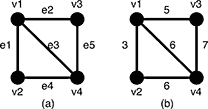POJ 3522 Slim Span(MST)
来源:互联网 发布:bluehost域名续费 编辑:程序博客网 时间:2024/05/18 02:17
Description
Given an undirected weighted graph G, you should find one of spanning trees specified as follows.
The graph G is an ordered pair (V, E), where V is a set of vertices {v1, v2, …, vn} and E is a set of undirected edges {e1, e2, …, em}. Each edge e ∈ E has its weight w(e).
A spanning tree T is a tree (a connected subgraph without cycles) which connects all the n vertices with n − 1 edges. The slimness of a spanning tree T is defined as the difference between the largest weight and the smallest weight among the n − 1 edges of T.

Figure 5: A graph G and the weights of the edges
For example, a graph G in Figure 5(a) has four vertices {v1, v2, v3, v4} and five undirected edges {e1, e2, e3, e4, e5}. The weights of the edges are w(e1) = 3, w(e2) = 5, w(e3) = 6, w(e4) = 6, w(e5) = 7 as shown in Figure 5(b).

Figure 6: Examples of the spanning trees of G
There are several spanning trees for G. Four of them are depicted in Figure 6(a)~(d). The spanning tree Ta in Figure 6(a) has three edges whose weights are 3, 6 and 7. The largest weight is 7 and the smallest weight is 3 so that the slimness of the tree Ta is 4. The slimnesses of spanning trees Tb, Tc and Td shown in Figure 6(b), (c) and (d) are 3, 2 and 1, respectively. You can easily see the slimness of any other spanning tree is greater than or equal to 1, thus the spanning tree Td in Figure 6(d) is one of the slimmest spanning trees whose slimness is 1.
Your job is to write a program that computes the smallest slimness.
Input
The input consists of multiple datasets, followed by a line containing two zeros separated by a space. Each dataset has the following format.
Every input item in a dataset is a non-negative integer. Items in a line are separated by a space. n is the number of the vertices and m the number of the edges. You can assume 2 ≤ n ≤ 100 and 0 ≤ m ≤ n(n − 1)/2. ak andbk (k = 1, …, m) are positive integers less than or equal to n, which represent the two vertices vak and vbk connected by the kth edge ek. wk is a positive integer less than or equal to 10000, which indicates the weight ofek. You can assume that the graph G = (V, E) is simple, that is, there are no self-loops (that connect the same vertex) nor parallel edges (that are two or more edges whose both ends are the same two vertices).
Output
For each dataset, if the graph has spanning trees, the smallest slimness among them should be printed. Otherwise, −1 should be printed. An output should not contain extra characters.
Sample Input
4 51 2 31 3 51 4 62 4 63 4 74 61 2 101 3 1001 4 902 3 202 4 803 4 402 11 2 13 03 11 2 13 31 2 22 3 51 3 65 101 2 1101 3 1201 4 1301 5 1202 3 1102 4 1202 5 1303 4 1203 5 1104 5 1205 101 2 93841 3 8871 4 27781 5 69162 3 77942 4 83362 5 53873 4 4933 5 66504 5 14225 81 2 12 3 1003 4 1004 5 1001 5 502 5 503 5 504 1 1500 0
Sample Output
1200-1-110168650
/*79ms,208KB*/#include<cstdio>#include<algorithm>using namespace std;const int N = 101;const int M = 5001;const int INF = 0x7fffffff;int fa[N], rank[N], n, m;struct edge{int a;int b;int w;} edges[M];bool cmp(const edge a, const edge b){return a.w < b.w;}int find_set(int n){if (fa[n] == n)return n;fa[n] = find_set(fa[n]);return fa[n];}bool union_set(int a, int b){int ra = find_set(a);int rb = find_set(b);if (ra != rb){if (rank[ra] >= rank[rb]){fa[rb] = ra;rank[ra] += rank[rb];}else{fa[ra] = rb;rank[rb] += rank[ra];}return true;}return false;}int main(){int i, j;int num;int min;int fedge, ledge;while (scanf("%d%d", &n, &m), n){min = INF;bool flag = false;for (i = 1; i <= m; i++)scanf("%d%d%d", &edges[i].a, &edges[i].b, &edges[i].w);sort(edges + 1, edges + m + 1, cmp);if (n == 2 && m == 1){printf("0\n");continue;}for (j = 1; j <= m; j++){num = 0;for (i = 1; i <= n; i++){fa[i] = i;rank[i] = 1;}for (i = j; i <= m; i++){if (j + n - 2 > m){flag = true;break;}if (union_set(edges[i].a, edges[i].b)){ //for (i = 1; i <= n; i++) //{ //printf("%d %d\n",fa[i],rank[i]); //}num++;if (num == 1)fedge = edges[i].w;else if (num == n - 1){ledge = edges[i].w;if (ledge - fedge < min)min = ledge - fedge;break;}}}//printf("\n");if (flag)break;}printf("%d\n", min != INF ? min : -1);}return 0;}- POJ 3522 Slim Span(MST)
- POJ 3522 Slim Span MST变形
- POJ 3522 Slim Span
- poj 3522 Slim Span
- POJ 3522 Slim Span
- poj 3522 Slim Span
- poj 3522 Slim Span
- poj 3522 Slim Span
- poj 3522 Slim Span
- POJ 3522 Slim Span
- poj 3522 Slim Span
- POJ 3522 Slim Span
- poj 3522 Slim Span
- poj 3522 Slim Span
- POJ 3522 Slim Span
- POJ 3522 Slim Span
- poj 3522 Slim Span
- POJ 3522 Slim Span
- QTreeWidget的用法
- 在CentOS 6 的cron/crontab中使用wine运行exe程序
- 【xinfanqie】菜鸟收藏:不为人知的VAR函数设置
- android google maps之 简单交通图(一)
- Sys.WebForms.PageRequestManagerServerErrorException: 在服务器上处理请求时出现未知错误。服务器返回的状态码为: 500
- POJ 3522 Slim Span(MST)
- 学生信息管理系统第一次验收后的改进
- Spring mvc web.xml
- NFS服务的配置及启动
- oracle restart介绍
- qtreewidget
- android 开发笔记二
- android的ndk里面编译boost
- 线性代数:转置矩阵


